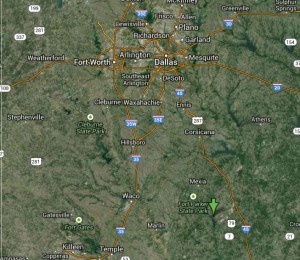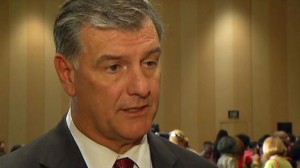Natural Gas
Don’t Miss the Big D Finale to the Dallas Gas Wars On Wednesday
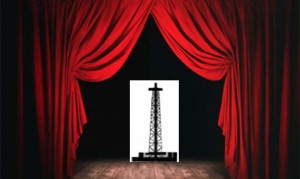 It All Comes Down To This Last Public Hearing and Final Vote on a New Drilling Ordinance
It All Comes Down To This Last Public Hearing and Final Vote on a New Drilling Ordinance
Beginning 1:00 PM
THIS WEDNESDAY, DECEMBER 11th
6th Floor Dallas City Hall
Participate, and (with any luck) Celebrate…..Over a Year of Constant Activism…….Over Three Years of Constant Organizing…….The Defeat of the Trinity East Permits………The Passage of Protective Dallas Gas Ordinance
After the Vote at City Hall. Come Raise a Glass with us at Lee Harvey's Bar, at 1807 Gould St.
THIS WEDNESDAY'S SCHEDULE
1:00 pm
Citizens' Press Conference
with special guests
1:30 pm
Final City Council Public Hearing on Gas-Drilling
ordinance
Following the Public Hearing, the City Council will have its final vote on the ordinance
Following the Council's vote, we'll reconvene at Lee Harvey's, the official bar of the Dallas Gas Wars.
Even if you Don't Live in Dallas, You Can Help Us Bring the REAL Barnett Shale to the Public Hearing on Wednesday
One of the constant refrains of our opponents on the Council is that drilling has been "going on for years in the Barnett Shale with no apparent harm." In particular, they love to use Fort Worth as a model for how Dallas should regulate gas drilling.
We know many of you have a different story to tell because you've experienced drilling up close and personal, or have family or friends who have.
The Dallas Residents at Risk alliance has put out a call for Wednesday's public hearing on the new gas ordinance that will proceed the final vote.
We're asking residents of the Barnett Shale who've been harmed by drilling to submit their testimony to the Dallas City Council.
You can do this directly by coming to the hearing Wednesday afternoon and testifying yourself, or you can submit you testimony to us at info@downwindersatrisk.org and we'll ask a Dallas resident to read it into the record for you.
We'll have these first-hand statements available for Dallas residents who want to help read them into the record at the 1pm press conference preceding the public hearing.
Our goal is to paint a more realistic picture of what it's like to live with gas drilling and production on a daily basis before the final vote on a new Dallas gas ordinance is taken. Please help us paint that picture.
How The Vote Looks as of Monday
Whatever happens on Wednesday, it'll be a close vote. There are still six votes against the new ordinance, and six votes for it. Mayor Rawlings, and Council members Jennifer Staubach-Gates and Dwaine Caraway are all officially undecided and hold the key to victory for either side. We must have at least 8 out of the 15 members vote with us to win.
Thanks to you, each of these three officially-undecided council members has received hundreds of e-mails supporting the new ordinance and its 1500-foot setback over the past week or so. We understand that they may be having an impact, along with phone calls, visits, and everything else residents are doing to try and persuade these three Council members to do the right thing. (If you still want to reach them here's their contact info.)
Thank you for doing all that you've done. We couldn't have gotten as far as we have without our army of citizen-lobbyists. But now we need your butt in a seat one last time at City Hall on Wednesday to close the deal. Please come if you can. Thanks.
D-Day Minus 7: Dallas Gas Ordinance Countdown
Considering how little public notice there was, yesterday's Dallas City Council "public comment time" on the new gas-drilling ordinance was well-attended by residents supporting the Plan Commission Draft. Over two dozen people spoke in favor of the CPC recommendations, including the 1500 foot setback, and/or stronger language for parks and flood plains. Murky statements by the Mayor about whether speaking this week would disqualify you from also having your say at next week's public hearing immediately prior to the final Council vote kept other residents from going to the podium.
True to whatever consultant's media training rule book they're following, industry representatives waited until they thought citizen testimony ended to make their condescending case that citizens were relying only on fear and didn't really understand the fracking process. The problem with this strategy is that you have to pretend the previous 45 minutes of citizen testimony never happened, since it's always replete with references to new scientific studies showing increased health harms from fracking, or another connection with earthquakes, or just strange foamy crap falling out of the sky into your yard from the rig down the street. It turns out the industry folks are the ones who don't really know the process.
And as fate would have it, citizens weren't through testifying. Right after telling the City Council how much West Dallas would lose out by not embracing fracking in its neighborhoods, up popped a West Dallas resident who said she wanted nothing to do with the industry, no matter how much money was involved. After another industry spokesman again said supporters of a stronger ordinance were just imagining harms they weren't really there, Sierra Club member Molly Rooke gave a devastatingly effective presentation on exactly how real harms to real people had forced her own group to acknowledge the dangers of gas pollution after initially endorsing natural gas as an entirely green fuel.
Unlike the staff briefing of two weeks ago, which allowed industry supporters on the Council to bloviate at will over what a crime it was to limit drilling in Big D, nobody behind the horseshoe did any talking except the Mayor, who was perfunctory in his opening and closing remarks and didn't give any clues as to his position on the CPC draft. According to Rawlings, it was his idea to have this "public comment time" prior to the final hearing so there wouldn't be the pile-up there was during the Trinity East vote, where you felt more like you were a cog in an assembly line instead of a citizen participating in one the small pageants of American democracy.
At the end of the meeting, Texas Campaign for the Environment members unfurled a banner urging Rawlings to "Be Strong," which was quickly confiscated by the City Hall Police Rapid Protest Response Team. Here's the Dallas Morning News' muted coverage of the event.
Because of the weather, Dallas Residents at Risk is waiting until next Monday to gin up a final push for passage of the Plan Commission draft going into Wednesday's final public hearing and vote beginning at 1 pm at City Hall. Please stay tuned for details about how you can express your public support and send a message to the Council to pass a strong ordinance. We know we sound like a broken record, but if you haven't sent a quick e-mail to the Mayor yet, you can click here and do so within a minute pretty painlessly. If you want a short explanation of what's going and what votes are where, you can read this previous post and get caught-up.
We have only a week to make sure our last year's worth of hard uphill slogging through corruption, double-dealing, and aggressively ignorant bureaucracies is not in vain. Please help us make it the last 1500 feet.
D Day (Drilling Day) Minus 8: Latest on Dallas Gas Ordinance
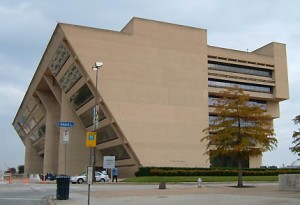 If you can, please be sure and attend and speak-up during the public comment time being offered by the Dallas City Council today at 1 pm. Although hastily-called on the day before Thanksgiving, this "unofficial" hearing is a chance for you to speak to Council Members while things still seem to be in motion at City Hall, as opposed to next Wednesday's official hearing and vote, when things might have already been settled.
If you can, please be sure and attend and speak-up during the public comment time being offered by the Dallas City Council today at 1 pm. Although hastily-called on the day before Thanksgiving, this "unofficial" hearing is a chance for you to speak to Council Members while things still seem to be in motion at City Hall, as opposed to next Wednesday's official hearing and vote, when things might have already been settled.
In other ordinance-related news……
– The Dallas Morning News published an excellent editorial in today's edition (reprinted below) urging the council to approve the City Plan Commission draft ordinance as is. "Council members should remember that their first obligation is to protect existing neighborhoods. This proposal is reasonable and offers far better protections for residents than had existed on the books. The council should adopt it."
– According to more than one source at City Hall, Dallas "Sustainability Department" staffer David Cossum, and our old friend City Attorney Tammie Palomino were going door-to-door through the council members offices trying to drum up support for a 1500 foot maximum buffer zone that then could be reduced to as little as 500 feet with a "variance." This is an option that has never been on the table before – it was never discussed by the Plan Commission, who wanted a 1000 foot minimum. You'll recall these are the same City Hall staffers who lead the Gas Drilling Task Force down the garden path to carve out exemptions for the Trinity East permits without public knowledge. They are the same staffers who tried more than once to get the Plan Commission to back down from their support of a 1500 foot setback. According to our sources, the pair failed in getting the majority support they needed to go forward with their scheme. If you think ex-but-still-hanging-around former City Manager Mary Suhm isn't still having an impact at 1500 Marilla, this news should set you straight.
– There's a rumor of a deal between Council factions that would preserve the 1500 foot setback but allow variances down to 1000 feet on a 2/3rds vote, instead of the super majority 3/4's proposed by the City Plan Commission. In other words, a motion to reduce the setback or buffer zone from 1500 to 1000 feet for any well would require at least 6 votes to block under the 2/3rds provision vs. just four members having veto power under a 3/4's rule. We haven't heard a single argument to explain why this tweak is necessary or desirable. It could be petty politics – Rawlings doesn't want Griggs and Company having full veto power. Or it could be something more strategic that has to do with a specific site or operator, the way the City tried to shape the Task Force recommendations for the Trinity East permits without the public knowing what was going on.
If you haven't sent an e-mail to Mayor Rawlings requesting that he vote for the Plan Commission draft and its 1500 foot setback, please click here now and do so. And here's yesterday's post explaining the situation, and offering the e-mail addresses and phone numbers of Mayor Rawlings, Jennifer Staubach-Gates and Dwaine Caraway in case you want to contact the only three uncommitted council members left.
You only have until next Wednesday to influence these votes on the Council. Then it's all over, so please, do it now. Thanks.
Editorial: Dallas must not weaken balanced gas drilling rules
After nearly two years of contentious political haggling, the Dallas City Council will hear public comments Wednesday on proposed tougher gas drilling rules, the final step before the council votes on the plan next Wednesday. This newspaper urges council members to resist pressure to water down the City Plan Commission’s strong measure and adopt those recommendations in their entirety.
The Plan Commission has done a lot of hard work, resulting in new rules that fairly balance the rights of drillers against protections for Dallas neighborhoods from downsides of urban drilling.
For example, the commission is urging the council to enact a minimum 1,500-foot buffer zone around drilling sites, with a provision allowing a reduced 1,000-foot buffer zone in certain circumstances. That was a wise, hard-fought compromise intended to assure neighborhoods are free from excessive noise and possible health threats, and it is in line with setbacks enacted in other North Texas cities, such as Flower Mound.
It is also a major improvement over Dallas’ current rule, which permits drilling within 300 feet of schools, churches and residential areas. Although some council members say the 1,500-foot setback might draw a lawsuit from drillers, the greater distance setback is in the best interests of Dallas residents.
Other key provisions would require drillers to disclose all hazardous materials used on a drilling site, restrict drilling during droughts, and ban wastewater injection wells, which some experts suspect are tied to earthquake activity. We’re also impressed that plan commissioners are urging the council to consider establishing a pollution-offsets program to make sure drilling won’t undermine the region’s overall efforts to clean the air. These all are reasonable and extremely important safeguards that need to be in place before urban drilling is allowed.
Unfortunately, the commission didn’t recommend an outright ban on drilling in floodplains and on parkland, but at least the panel has recommended that the council set a reasonably high bar — a three-quarters vote — before drilling would be permitted in parks.
Overall, this is a good ordinance because it doesn’t give drillers carte blanche yet recognizes that urban gas drilling is part of America’s energy future. Nor does the proposal let the perfect be the enemy of the good. Thus the council should not undo the constructive work of plan commissioners with last-minute changes that would weaken the ordinance.
Council members should remember that their first obligation is to protect existing neighborhoods. This proposal is reasonable and offers far better protections for residents than had existed on the books. The council should adopt it.
KEY VICTORIES
• Setbacks of drilling operations from schools, churches and homes to a minimum 1,500-foot buffer zone around all sites. Drillers could request a 1,000-foot zone in certain circumstances.
• Authority for the city to impose water restrictions during drought conditions.
• Requirement for drillers to disclose all hazardous materials used on a site.
• Ban on wastewater injection wells from being drilled within city limits.
• Proposed pollution-offsets program to protect air quality.
The New Gas Pollution Problem for DFW in Two Pictures
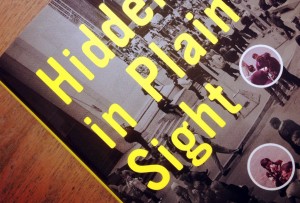 So far the debate over how much impact the gas industry has had on DFW air quality has centered on the Barnett Shale. That's logical because that's the gas play right in front of us, in the middle of the North Texas "non-attainment area" for smog. One of the main arguments Rick Perry's Texas Commission on Environmental Quality has made against any significant impact is that most of the drilling is happening west of the DFW urban centers.
So far the debate over how much impact the gas industry has had on DFW air quality has centered on the Barnett Shale. That's logical because that's the gas play right in front of us, in the middle of the North Texas "non-attainment area" for smog. One of the main arguments Rick Perry's Texas Commission on Environmental Quality has made against any significant impact is that most of the drilling is happening west of the DFW urban centers.
Ignoring how geographically-incorrect this argument is – there's drilling and compressors in Dallas County right now, much less Ellis, Johnson. Denton and Tarrant – let's just cede the argument to the state that it would take gas fields to the Southeast of us, that is, upwind of us during ozone season, to really impact our air quality.
Guess what? There's gas fields Southeast of DFW that are producing lots of air pollution.
In previous posts over at least the last two years, we've shown that if you add up the standard permits of all the gas compressors in Freestone County alone, they represent more smog pollution than the Big Brown Coal Plant doing business down the road. Now there's new evidence of the size of these gas fields and their relationship to the DFW airshed, thanks to Google.
Here's a picture of the area we're talking about – just about an hour and a half drive southeast of DFW, east of Waco. That makes it directly upwind during ozone seasons.
When you zoom into where the green arrow is, you see the familiar sight of hundreds of square drilling pads laid out over the landscape – just like the Barnett Shale – only DFW is directly downwind of it during the summer.
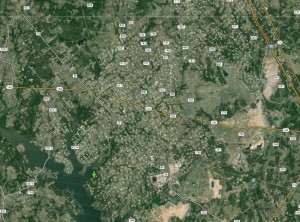 Pollution from these sources has most likely been grossly underestimated by the state. Moreover, when gas field pollution comes into an urban area with dirty air, it increases the likelihood of that pollution turning into smog. Rick Perry's employees are loath to admit the gas industry plays any part in the stagnation of DFW air quality progress since 2007, but as these images make clear, facts on the ground trump their ideology.
Pollution from these sources has most likely been grossly underestimated by the state. Moreover, when gas field pollution comes into an urban area with dirty air, it increases the likelihood of that pollution turning into smog. Rick Perry's employees are loath to admit the gas industry plays any part in the stagnation of DFW air quality progress since 2007, but as these images make clear, facts on the ground trump their ideology.
9 Days Until the End of the Dallas Gas Wars: What You Can Do
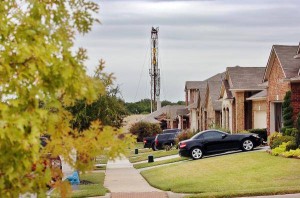 We only have 9 days to protect what it's taken us at least the last 12 months to build. The final Dallas City Council vote on a new gas drilling ordinance will take place on Wednesday, December 11th.
We only have 9 days to protect what it's taken us at least the last 12 months to build. The final Dallas City Council vote on a new gas drilling ordinance will take place on Wednesday, December 11th.
THIS WEDNESDAY – Tomorrow
December 4th
1 pm
Dallas City Council Mtg.
Dallas City Hall 6th Floor
Public Comment Being Taken on New Gas Drilling Ordinance
NEXT WEDNESDAY
December 11th
1 pm
Dallas City Council Mtg.
Dallas City Hall 6th Floor
Public hearing and VOTE on new Gas
Gas Drilling Ordinance
If you've come to City Hall on this issue recently, thank you, but we need you to show up again in the next two weeks and make sure our previous victories remain intact.
If you haven't shown up yet, or it's been a while, we really need some fresh faces to speak up and support the strongest ordinance we can get.
What's at Stake:
The 1500-foot buffer zone between drilling and compressor stations and neighborhoods.
This 1500-foot "setback" was supported by a 14-1 vote of the City Plan Commission in its recommendations to the City Council. It applies not only to gas drilling sites, but to large compressor stations too.
Flower Mound has a 1500-foot setback. The Lubbock Health Board has recommended a 1500-foot setback for that city. Denton has just voted for a 1200-foot setback.
Yet at least six city council members (Jerry Allen, Sheffe Kadane, Vonciel Hill, Tenell Atkins, Lee Kleinman, and Rick Callahan want to rollback that distance to allow drilling and compressor stations within just 1000 feet of neighborhoods and schools, and with "variances," as close as 500 feet.
Recently, old wells were activated in Denton that are as close as 600 feet to homes that were built since the leases were granted. According to press coverage last week, "residents in the Vintage neighborhood were not happy when they noticed "vibrations, noise and glare" about 600 feet from their homes…."
The disruption was so great that the City of Denton sued the gas drillers. "The actions of the Defendants are causing immediate and irreparable harm," the city's lawsuit said.
The Politics:
This is the kind of heavy industry these six city council members want to bring to Dallas neighborhoods, and they'll succeed if they can get Mayor Rawlings, Jennifer Gates and/or Dwaine Caraway to agree with them.
The rest of the council has made up its mind. It's the six backers of industry listed above vs. the six council members who voted to reject the Trinity East permits (Scott Griggs, Philip Kingston, Monica Alonzo, Adam Medrano, Sandy Greyson, and Carolyn Davis). Any motion needs 8 vote to win.
That's why these three Council members – Mayor Rawlings, Jennifer Gates, and Dwaine Caraway – will determine whether Dallas gets a more, or less protective gas drilling ordinance.
Mayor Rawlings has gone on record as opposing gas drilling in Dallas on principle. He's also gone on record saying he'd support the CPC recommendations. We need to make sure he keeps his word. He should be leading the charge for the most protective ordinance we can get.
Jennifer Gates ran on a platform of keeping drilling out of neighborhoods. We need to remind her of that and that she too needs to be leading the fight to keep the 1500 foot setback.
Dwaine Carway needs to be reminded that gas drilling is an environmental justice issue that will disproportionately hurt low income and minority areas of Dallas.
WHAT YOU CAN DO TO HELP:
1) Attend one or both of the next City Council meetings and ask the Council to pass the draft gas ordinance that the City Plan Commission recommended, including the 1500 foot setback.
2) If you haven't already, click here and send the Mayor a quick "click n' send" e-mail asking him to keep his word and support the Plan Commission recommendations iin total, including the 1500 foot setback. Please do this asap.
(We've added the e-mail addresses of both Jennifer Gates and Dwaine Carraway to the message to make sure they know how you feel.)
3) Contact Mayor Rawlings, Jennifer Gates and Dwaine Caraway on your own:
Mayor Rawlings
mike.rawlings@dallascityhall.com
Adam McGough, Chief of Staff
Phone: 214-670-7894
Dwaine Caraway
dwaine.caraway@dallascityhall.com,
214-670-0781
Jennifer Gates
Jennifer.gates@dallascityhall.com
Phone: 214-670-3816
4) Stay Tuned. They're more actions being planned leading up to the 11th so you can express your support for a strong ordinance. Keep on the lookout in your e-mailbox for alerts and on line here on the Downwinders' blog.
Scientific Support For a 1500-foot Setback
The 2012 Colorado School of Public Health study of cancer and non-cancer risks in the gas field, entitled "Human health risk assessment of air emissions from development of unconventional natural gas resources." This study concluded that residents living within a half-mile of a gas well had a 66% higher incidence of cancer than those living further away from a well.
The 2013 Emory University study found the risk of developing non-Hodgkin lymphoma increased among those living in proximity to facilities that release benzene. Natural gas facilities can release a lot of Benzene.
A 2012 report from Cornell University found that a mother's exposure to fracking before birth increases the overall prevalence of low birth weight by 25 percent.
Another 2012 Cornell University study that focused on animal health in the gas field concluded that reduced milk production, gastrointestinal, neurological, urological issues and sudden death are just a few of the symptoms experienced by livestock living near natural gas fracking sites.
Dr. Vikas Kapil of the National Center for Environmental Health at the U.S. Centers for Disease Control and Prevention gave a presentation in January 2012, saying "We do not have enough information to say with certainty whether shale gas drilling poses a threat to public health."
In addition, the Army Corp of Engineers recommends a distance of 3000 feet between structures like dams and levees and gas wells because of the danger of vibrations to structural integrity. If this distance is good enough for a dam, it's good enough to protect a home's foundation.
Smokey Joe Barton: the Frackers’ Favorite Congressman
 On Wednesday the DC-based campaign money watchdog group, Citizens for Responsibility and Ethics in Washington (CREW) released a report totaling up all the contributions to Congress from the nation's fracking industry fom 2004 to 2012 and found, to absolutely no one's surprise, that our own Smokey Joe Barton led all comers with over half a million of grateful cash collected.
On Wednesday the DC-based campaign money watchdog group, Citizens for Responsibility and Ethics in Washington (CREW) released a report totaling up all the contributions to Congress from the nation's fracking industry fom 2004 to 2012 and found, to absolutely no one's surprise, that our own Smokey Joe Barton led all comers with over half a million of grateful cash collected.
Since he was Chairman of the House Energy Committee for two of those years, and successfully led the effort to exempt fracking from federal environmental laws in the 2005 Energy Act, Barton is a favorite industry recipient.
But even the House Republicans have their limits. After his disastrous 2006 apology to former BP Chairman Tony Hayward for the White House's demand for $20 billion from the company for help in cleaning up its huge Gulf oil spill, the GOP decided that perhaps Smokey Joe wasn't the best face they cold put on energy policy and replaced him as Chairman. Now he's the senior member of his own Committee but isn't running it. Because this kind of money follows power, most of his large eight year total came before Barton got kicked to the gutter by his own party.
And it's why in just one campaign and less than two years, Texas' junior Senator Ted Cruz has already collected more than half of Barton's total, almost $300,000, from frackers, just shy of the amount our Senior Senator John Cornyn brought in over a much longer period of time. The industry is buying lots of tickets to climb aboard the Cruz presidential campaign band wagon. In another year's time it won't be shocking if Cruz surpasses Barton, even though he's not a Committee Chair or holds nay special influence in the Senate.
Dallas Ordinance Rolled Back Behind Closed Doors? 1500 Foot Buffer Zone In Danger on December 11th
 Wednesday's public staff briefing over the new gas drilling ordinance at Dallas City Hall was every bit as biased as you'd expect from a group that's been chafing under the Plan Commission's progressive recommendations since summer.
Wednesday's public staff briefing over the new gas drilling ordinance at Dallas City Hall was every bit as biased as you'd expect from a group that's been chafing under the Plan Commission's progressive recommendations since summer.
But it's the snow job that went on in he lengthy two-hour Executive Session that should really concern you – the one where the city attorney basically said Dallas would get sued if it adopted the Plan Commission's proposed 1500-foot setback that would separate neighborhoods from gas wells and compressor stations. It's when they're aren't any cameras or members of the public in the room that staff roll out their most spectacular spin. And the threat of a lawsuit is always good for a scare too.
As it happens, Flower Mound has saved Dallas a lot of trouble. That city also has a 1500 foot setback. And in fact, gas companies HAVE sued Flower Mound. And each time, Flower Mound has won.
And then there's Lubbock. Lubbock! A city where there are two political parties: Republicans and Libertarians. Lubbock's Board of Health recommended a setback of 1500 feet.
And yet, the Dallas City Council could end up running away from a standard even Lubbock doctors endorse come the December 11th vote on a new ordinance.
There are at least five very pro-industry members of the Dallas City Council who are now trying very hard to reduce that proposed 1500-foot setback to 1000 feet or less – Vonciel Hill, Jerry Allen, Sheffie Kadane, Terrell Atkins, and Rick Callahan. All of them were quite vocal in the Q&A session that followed the briefing yesterday, tripping over each other in carrying the industry's water, and all aiming at the 1500-foot setback, the linchpin of the Plan Commission's protections. You can read the DMN description of the sorry episode here.
What we still don't know after today is where the Mayor stands. He hemmed and hawed about public safety and fiduciary responsibility but didn't come down on one side or the other. Neither did Jennifer Gates. Or Dwaine Caraway. (Lee Kleinman was MIA.) These remain the only real unknowns, since citizen groups are expecting their six anti-Trinity East votes to hold here too. And of these unknowns, the Mayor is the most critical. He's on record as saying he'll support the CPC recommendations. Residents must make him accountable for that promise, or find themselves the victim of a policy that was made-up and decided behind closed doors.
To help you do just that, we've got a quick click and send e-mail you can use to tell Mayor Rawlings you want him to use his decisive vote to support the 1500-foot setback and the other provisons of the City Plan Commission draft ordinance.
It's not the only thing citizens need to do to mobilize between now and the December 11th public hearing and vote, but it's a start. Use it today.
Dallas Gas Ordinance Update: Council Briefing Wednesday, Council Hearing and Vote December 11th
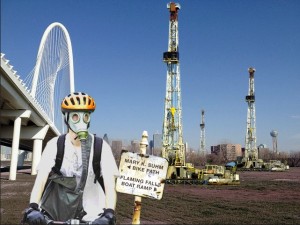 Mark your calendars now. According to City of Dallas materials published online Friday, the final council hearing and vote on a new gas drilling ordinance will take place Wednesday, December 11th.
Mark your calendars now. According to City of Dallas materials published online Friday, the final council hearing and vote on a new gas drilling ordinance will take place Wednesday, December 11th.
We might have a better idea about the likely outcome of that vote after tomorrow's briefing to the council by staff on the City Plan Commission recommendations that were adopted back in September. That's scheduled to take place between 9 am and lunch according to the council's agenda. Observers will be listening carefully to the comments and questions of the Mayor and Council to discern whether there are eight solid votes to adopt what's widely considered to be one of the most progressive gas drilling ordinances in the Barnett Shale, or whether opponents will have an opening to rollback key provisions, starting with the 1500-foot setback.
Rumor has it that work is already being done by at least one or two council members to write amendments to the Plan Commission draft to do just that. This is industry's last stand and they aren't likely to sit n their hands. Expect at least three to five hardcore driller-friendly council members to try and mount a charge. But they need eight to win.
As we've already noted, this is all now coming down to whether Mayor Rawlings will keep his word and support the product of the Plan Commission, as he said he would during his late August Trinity East soliloquy. If he likes the draft as is, chances are that's what we'll see adopted on the 11th. If he wants to tinker with it, then he'll allow that. The problem with opening it up to itemized changes is that nobody can predict what changes will win and what changes will lose, or how long such an amending process might take for such a detailed document. Things could get very messy and long.
Downwinders will be at tomorrow's staff briefing, trying to read the tea leaves like everyone else. We'll have a summary by tomorrow afternoon or Thursday morning. Stay tuned.
Something Wicked This Way Blows…..
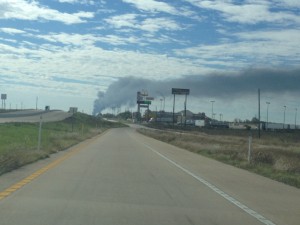 Events like the gas pipeline explosion in Milford are graphic reminders of just how vulnerable our North Texas air shed is to pollution sources from Ellis County. Proximity, predominant wind patterns, and potential for disaster combine to make our Southern neighbor a constant threat.
Events like the gas pipeline explosion in Milford are graphic reminders of just how vulnerable our North Texas air shed is to pollution sources from Ellis County. Proximity, predominant wind patterns, and potential for disaster combine to make our Southern neighbor a constant threat.
On Thursday, one could see the plume of smoke stretch out south to north across the entire Metromess. It's a safe bet that not too many of the 6 million plus residents of greater DFW knew there was a town called Milford near them at the beginning of the day, but a lot of them had inhaled Milford soot by evening.
That would be the same soot that reporters keep reminding us "the EPA" says is "non-toxic," based on measurements. Except there is no such thing as non-toxic smoke from a combustion source, which the Milford explosion and fire most certainly was. All combustion produces soot, or Particulate Matter. According to the latest evidence from research scientists, there is no safe level of exposure to PM Pollution. That is, any amount of PM pollution can do human health damage. Even short-term exposure can lead to asthma attacks, heart attacks and strokes. How do we know this – the EPA tell us so on their own website.
Only a couple of years ago, the Magnablend fire in Waxahachie poured its own plume of "non-toxic" smoke into DFW skies, despite the incineration of a large variety of chemicals used in the oil and gas industry. You might remember the water run-off from fighting that fire went into a creek and killed a lot of fish. But don't worry, that same stuff in your lungs is nothing to worry about. Perfectly natural to be able to see what your breathing.
Perhaps the most spectacular modern reminder of how close Ellis County is to us in air miles came back in 1995 when a Midlothian-based tire dump, called…wait for it…."Safe Tire Disposal Company" that was actually a collection site for the nearby cement plant tire-burning operation caught fire its own self.
There are fires, and then there are tire fires. They burn extremely hot, produce a lot of that "non-toxic" smoke, and can keep going for days. And that's exactly what happened in Midlothian. The predominant southerly winds carried all that dark dense smoke right into Downtown Dallas, where it surrounded and engulfed whole office buildings.
Timing is everything and so it was with the Safe Tire Fire. It happened at the exact moment when local citizens were engaged in very public debate with state and local officials over whether air pollution from the three large cement plants in Midlothian (two of which were burning tires) could impact air quality in DFW. You read that correctly. In 1995, citizens were still trying to make the case that millions of pounds of air pollution released just across the Dallas and Tarrant County lines could possibly have a negative impact on metropolitan smog levels. And it was an uphill fight. Officially, there was no confirmation of the impact of these facilities. The DFW air plan stopped at the County Line. Unofficially, you could see the cement plant smokestacks as you drove I-20 across Grand Prairie and Arlington.
When those tires went up in smoke, so did the arguments being used to downplay the impact of Ellis County pollution. It was like adding a dark black dye to the North Texas air flow, beginning in Midlothian, and watching it be carried downstream/downwind right into the heart of downtown Dallas. It was the most defiant demonstration of the citizen's arguments one could imagine. After that, it was a lot easier for everyone to understand Midlothian was only a breeze away from their lungs.
With yet another fire in Ellis County setting off yet another dark, thick plume of smoke that wafts into DFW, we get a reminder of how much closer together the air brings us. Only about half an hour or so away from Milford, a little bit further south, is a new belt of natural gas compressors churning out voluminous amounts of air pollution that's being blown in the same direction as the smoke from that gas pipeline explosion. Unlike that smoke, pollution from these facilities will keep being released 24/7 for the foreseeable future. Add up all this new compressor pollution and it could rival the impact of a new coal plant – just upwind of us. Just because you can't see it doesn't mean it's not having an impact.
Once again, the state's position is that this pollution is no big deal. Once again, citizens are disagreeing. Who would you put your money on?
Dallas Drilling Update: It’s All About Holding Mayor Rawlings to His Word Now
“I am personally opposed to urban oil and gas drilling in Dallas.
To paraphrase Ecclesiastes, there is a place for everything under heaven, and I don’t think that place for drilling is in Dallas, in an environment like this.
We continue to grow, and there are generally too many unknowns in respect to urban drilling and its effects on our community’s health and safety. This city can be picky about what type of growth we have.
To that end, I will be supporting the efforts of our CPC on new gas drilling ordinances, to make sure the standards are such to ensure the safety of our citizens.”
– Dallas Mayor Mike Rawlings
August 28th, 2013
Statement before City Council vote on the Trinity East gas drilling and production Special Use Permits
On his way to vote in favor of allowing gas drilling in Dallas, the Mayor of North Texas' largest city seemingly endorsed a perpetual moratorium on gas drilling in Dallas.
And even as he endorsed a moratorium on gas drilling in Dallas, the Mayor also endorsed a City Plan Commission draft ordinance on gas drilling that still allows for it to take place, albeit under very selective conditions.
So which words from that August 28th declaration do we hold the Mayor to when the new gas ordinance comes up for a Council vote?
"I will be supporting the efforts of our CPC on new gas drilling ordinances"
That's all you need to know. There is no qualification there, no balance between the CPC draft and something else. Just full-throated endorsement of the draft, as is. Make him live up to this support in the form of a simple up-or-down vote on the entire ordinance and you've got one of the toughest new templates for how to regulate gas drilling in the state of Texas.
Forget about the first part. Even if you want a moratorium on drilling in Dallas, that's not the issue that will be up for a vote. Nor is there the slightest chance that such an option will appear as an alternative to the approval of a new gas ordinance, no matter how strongly Mayor Rawlings, or Scott Griggs, or Adam Medrano, or Philip Kingston personally feels about it. The choice is between the really bad old gas ordinance and the really good new gas ordinance.
Even if you think the ordinance could use improving (and everyone on this side of the aisle thinks it does), you don't have the votes on the council to improve it. Residents could only muster six "no" votes for the Trinity East fight. Fortunately, they only needed four. You need eight for each and every improvement you want to make to the gas ordinance. They aren't guaranteed.
Mayor Rawlings is one of only three or four mystery votes in the middle that determine the new ordinance's fate, and the most likely weather vane for the whole lot. As he goes, so probably goes North Dallas newcomers like Jennifer Gates and Lee Kleinman. Assuming residents can hold onto the "Trinity East Six," that gives you 8-9 votes. Then, seeing the winds shift, you don't know what other Council members you pick-up trying to get on the right side of things. Chances of improving the ordinance begin and end with the Mayor and what does the Mayor say? He's on the record as supporting the CPC draft, not the draft with some tweaks.
Of more concern to residents should be the eight votes that the other side might be able to muster to weaken some of the ordinance's key provisions by opening it up to individual itemized tallies. Industry starts out with at least five hard-core supporters. Add three votes to a rollback here or there, and the ordinance that it took months to make good might be completely unrecognizable by day's end. When you open up the draft to tweaks, you're taking a big gamble that you're only going to tweak it in good ways. There could be bad tweaks as well.
The safest, surest way to get what what industry is calling a de-facto moratorium on gas drilling in Dallas is having the Mayor agree to a single yes or no vote on the entire draft ordinance, an option he says he already supports. The new Dallas gas ordinance matches the lengthiest set backs in North Texas. It's tough on compressor pollution and location. It has robust disclosure language and insurance and bond requirements. It recommends a brand new air pollution off-set program for Dallas to explore. Is the ordinance perfect? No. But it's the best we can get with the votes that we have. And it's enough to keep drillers like Trinity East out of Dallas for good.
Improving it will take the assistance of Council members who aren't behind the dais yet. In the next municipal election cycle in 2015, almost half of the current City Council, and more than half of the ardent gas industry supporters, will be termed out. That's going to be the time to get the rest of your eight votes for a better gas drilling ordinance, and lots of other improvements as well.
Although there's still no date for an actual vote on the new gas ordinance, the city staff briefing – brace yourselves for one last Tammy Palomino appearance – to the Council is scheduled for the morning of Wednesday, November 6th at Dallas City Hall. If he Mayor wants this to go down smoothly, expect to hear a comment or two in support of the package as a whole being adopted. Residents might have a much clearer picture of where and how this will all be going down by session's end. Stay tuned.

